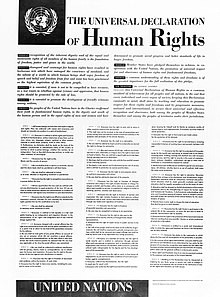
Universal Declaration of Human Rights
Declaration adopted in 1948 by the United Nations General Assembly / From Wikipedia, the free encyclopedia
Dear Wikiwand AI, let's keep it short by simply answering these key questions:
Can you list the top facts and stats about Universal Declaration of Human Rights?
Summarize this article for a 10 years old
The Universal Declaration of Human Rights (UDHR) is an international document adopted by the United Nations General Assembly that enshrines the rights and freedoms of all human beings. Drafted by a UN committee chaired by Eleanor Roosevelt, it was accepted by the General Assembly as Resolution 217 during its third session on 10 December 1948 at the Palais de Chaillot in Paris, France.[1] Of the 58 members of the United Nations at the time, 48 voted in favour, none against, eight abstained, and two did not vote.[2]
| Universal Declaration of Human Rights | |
|---|---|
 Eleanor Roosevelt holding the English language version of the Universal Declaration of Human Rights in November 1949 | |
 The human rights adopted by the United Nations General Assembly of its 183rd meeting, held in Paris on 10 December 1948 | |
| Created | 1948 |
| Ratified | 10 December 1948 |
| Location | Palais de Chaillot, Paris |
| Author(s) | Draft Committee[lower-alpha 1] |
| Purpose | Human rights |
| Official Website | |
| un.org/udhr | |
| Full Text | |
A foundational text in the history of human and civil rights, the Declaration consists of 30 articles detailing an individual's "basic rights and fundamental freedoms" and affirming their universal character as inherent, inalienable, and applicable to all human beings.[1] Adopted as a "common standard of achievement for all peoples and all nations", the UDHR commits nations to recognize all humans as being "born free and equal in dignity and rights" regardless of "nationality, place of residence, sex, national or ethnic origin, colour, religion, language, or any other status".[3]
The Declaration is considered a "milestone document" for its "universalist language", which makes no reference to a particular culture, political system, or religion.[4][5] It directly inspired the development of international human rights law, and was the first step in the formulation of the International Bill of Human Rights, which was completed in 1966 and came into force in 1976. Although not legally binding, the contents of the UDHR have been elaborated and incorporated into subsequent international treaties, regional human rights instruments, and national constitutions and legal codes.[6][7][8]
All 193 member states of the United Nations have ratified at least one of the nine binding treaties influenced by the Declaration, with the vast majority ratifying four or more.[1] While there is a wide consensus that the declaration itself is non-binding and not part of customary international law, there is also a consensus that many of its provisions are binding and have passed into customary international law,[9][10] although courts in some nations have been more restrictive on its legal effect.[11][12] Nevertheless, the UDHR has influenced legal, political, and social developments on both the global and national levels, with its significance partly evidenced by its 530 translations, the most of any document in history.[13]
